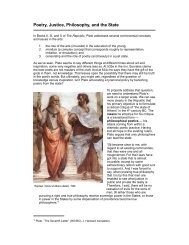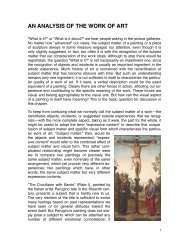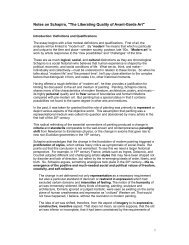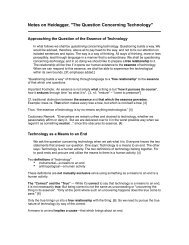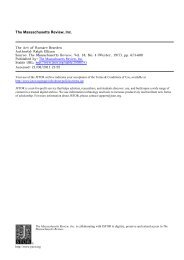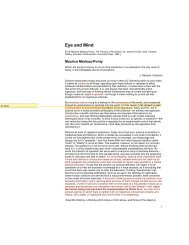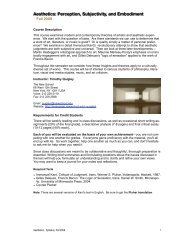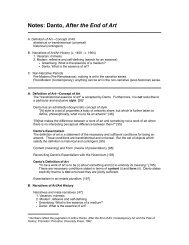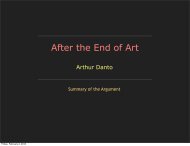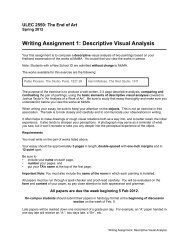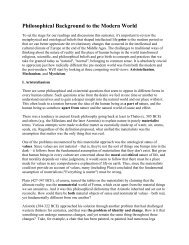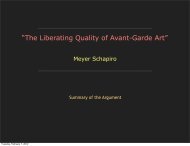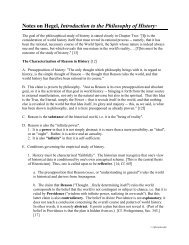Visual Analysis - Timothy R. Quigley
Visual Analysis - Timothy R. Quigley
Visual Analysis - Timothy R. Quigley
You also want an ePaper? Increase the reach of your titles
YUMPU automatically turns print PDFs into web optimized ePapers that Google loves.
Questions Raised by TaylorArt history is in the business of answering such questions, which providecrucial insight into one’s artistic experience.But this raises another question...Tuesday, January 24, 2012Pieter Bruegel the Elder, Peasant Dance, 1568
Questions Raised by TaylorWhy does a verbal description never seem to adequately represent avisual work of art?Taylor’s Hypothesis: The visual form of a painting exceeds any possibleverbal description, no matter how detailed and comprehensive thedescription may be.The visual and the verbal are two different modes of expression.Tuesday, January 24, 2012Pieter Bruegel the Elder, Peasant Dance, 1568
Questions Raised by TaylorBut how can the visual form of a painting in itself have meaning?To understand how meaning arises in a non-verbal way, we must firstdistinguish two things:Subject Matter — the object and events represented.Expressive Content — the combined effect of subject matterand visual form.Taylor’s analysis works back from the effectsproduced by the work of art — the expressivecontent — to the pictorial elements thatproduce those effects.Tuesday, January 24, 2012Philip Guston, The Studio, 1969
Taylor’s MethodologyEmpirical <strong>Analysis</strong> & ExplanationI claim Taylor is offering an hypothesis about the response of othersbased on his own personal, subjective response to the object.He’s working from a model which enables him to explain how works ofvisual art affect our thoughts and our feelings.Taylor uses formal analysis as one component of an empirical methodwithout appeal to natural laws or law-like relations.It’s a practice of art history as a kind of science.Let’s take a closer look at the components of Taylor’s model in action...Tuesday, January 24, 2012
Perugino: Components of the <strong>Analysis</strong>Color Scheme of Perugino’s PaintingThe effect of Perugino’s painting is producedin part through his use of color:• primary colors (red, yellow, blue)• balance of warm and cool colors• low levels of saturation(Exception: highly saturated red robe of St. John)• color keyed to the viewer’s emotional responseThe equilibrium and clarity of thecomposition affect its emotional quality.Both value and saturation are carefullymodulated.Tuesday, January 24, 2012Note how the feeling or mood of the composition shiftsslightly when the color balance is altered in the next slide...
Perugino: Components of the <strong>Analysis</strong>Effect of Changes in Color BalanceHere is an altered version of Perugino’spainting with all reds de-saturated orremoved.Note how• the clarity and contrast of thecomposition are lost,• leveling out the relations amongvarious elements in the picture and• altering the expressive content.Tuesday, January 24, 2012
Perugino: Components of the <strong>Analysis</strong>Tuesday, January 24, 2012
Perugino: Components of the <strong>Analysis</strong>Color Scheme of Perugino’s PaintingTaylor also notes that• we tend to relate similar hues,• strong contrasts attract attention,• gradual, rather than abrupt, changes invalue (light/dark) help move the eyesmoothly through various parts of thepicture.Color...does more than simply characterizegenerally the emotional climate of the work.The hues occur in different relationships,sometimes red next to yellow, sometimes rednext to blue, and in the background there is akind of sequence ranging from yellow throughgreen into blue.These relationships are made more complexand varied, by the modification of the hues inlight and dark, that is, in value, and insaturation. [Taylor, 3]Tuesday, January 24, 2012
Perugino: Components of the <strong>Analysis</strong>Line, Movement, and CompositionTaylor also considers the effect of theproportion and overall shape of the painting,Tuesday, January 24, 2012
Perugino: Components of the <strong>Analysis</strong>Line, Movement, and CompositionTaylor also considers the effect of theproportion and overall shape of the painting,Tuesday, January 24, 2012
Perugino: Components of the <strong>Analysis</strong>Line, Movement, and CompositionTaylor also considers the effect of theproportion and overall shape of the painting,as well as• the use of scale,Tuesday, January 24, 2012
Perugino: Components of the <strong>Analysis</strong>Line, Movement, and CompositionTaylor also considers the effect of theproportion and overall shape of the painting,as well as• the use of scale, and• rhythm (line and shape)Tuesday, January 24, 2012
Perugino: Components of the <strong>Analysis</strong>Line, Movement, and CompositionTaylor also considers the effect of theproportion and overall shape of the painting,as well as• the use of scale, and• rhythm (line and shape)• as well as the larger context.Tuesday, January 24, 2012
Crivelli: Components of the <strong>Analysis</strong>Color Scheme in Crivelli’s PaintingBased on• secondary and tertiary colors (variations of violet,orange, & green),• less clarity of color key (hues combine in areas),• less contrast of color elements (hue, saturation, value)“While no hue dominates this painting any more than it did thework of Perugino, there is not the effect of a color equilibriumexisting between well-defined entities. Rather there is theimpression of slightly distinguishable color notes rising above ageneral tone. Both the nature of the hues themselves and thefact that almost all are used in low saturation contribute to thiseffect of a somber and minor harmony.” [Taylor, 7f, emphases added.]Tuesday, January 24, 2012
Crivelli: Components of the <strong>Analysis</strong>Color Scheme in Crivelli’s PaintingBased on• secondary and tertiary colors (variations of violet,orange, & green),• less clarity of color key (hues combine in areas),• less contrast of color elements (hue, saturation, value)Because there are few value contrasts, theeye tends to move more rapidly over theentire painting.This effect is reinforced by numerous brokenplanes and jagged shapes.Tuesday, January 24, 2012
Crivelli: Components of the <strong>Analysis</strong>Tuesday, January 24, 2012
Crivelli: Components of the <strong>Analysis</strong>Rhythm and MovementTaylor also notes the differences in• line, movement, and composition;• proportional relation of parts;• expressive relation of bodily proportions.Tuesday, January 24, 2012
Pietro Perugino, Crucifixion with Saints (central panel)Carlo Crivelli, CrucifixionBut after all the analysis is done, Taylor reflects on the lack of finalityone tends to feel with the descriptive analysis of a work of art.He suggests it’s a virtue that points to the ineffable and sublime in art.Tuesday, January 24, 2012
Standard Elements of Descriptive <strong>Visual</strong> AnalysesColor — hue, saturation, valuePointLinePlaneMovement, ImpliedRhythmVolumeMassSpaceCompositionTextureShapeStyle — individual & collectivePractice using these elements to analyze the following pictures.Tuesday, January 24, 2012
Tuesday, January 24, 2012Johannes Vermeer, Girl with a Pearl Earring, 1665-7
Tuesday, January 24, 2012Henri Matisse, The Terrace: St. Tropez, 1904
Tuesday, January 24, 2012Pieter Bruegel the Elder, The Harvesters, 1565
Tuesday, January 24, 2012Romare Bearden, The Family, 1975
Tuesday, January 24, 2012Joan Mitchell, Untitled, 1962
Tuesday, January 24, 2012Berenice Abbott, "El" (2nd & 3rd Ave.), NYC, 1936
Tuesday, January 24, 2012Franz Kline, Four Square, 1956
Tuesday, January 24, 2012The Meaning of Life, Diesel Ad Campaign, Fall-Winter 1999
Tuesday, January 24, 2012<strong>Timothy</strong> <strong>Quigley</strong>, 2009 (revised 2012)



